



Manikarnika Ghat in Benaras
Now for another world altogether. BenaRas- the ‘ras’, the taste or essence of all things mixed together -'Bena'. Benaras, Kashi (The City of Light), Avimukta ( Never Abandoned) or what is now called Varanasi - (between the Varuna and the Asi Rivers) is perhaps the oldest, still-functioning city in the world. It was a flourishing city when what we know as civilization in the West was just being born.

"Are there not many holy places on this earth?
Yet which of them would equal in the balance one speck of Kashi’s dust?
Are there not many rivers running to the sea?
Yet which of them is like the River of Heaven in Kashi?
Are there not many fields of liberation on earth?
Yet not one equals the smallest part of the city never forsaken by Shiva.
The Ganga, Shiva, and Kashi: where this Trinity is watchful,
no wonder here is found the grace that leads one on to perfect bliss."
- Kashi Khanda 35. 7-10)
It is called the ancient city, the eternal city, ‘Older than history, older than tradition, older even than legend and looks twice as old than all of them put together,’ as Mark Twain said. I would add that Benaras has the highest density of myth, legend, and story of any city that I have ever been in. One is walking in and on a history that is still living, flourishing, and growing. Someone once said that a city is not, fundamentally, a geography or a history, neither a maze of streets nor a rational plan of settlement- a city is a myth and a story made manifest. I have never felt that more than in Benaras.
We arrived in the early evening and found a wonderful place to stay overlooking the Ganges, down a main alleyway to Assi Ghat. Beggars lined the streets, calling out to me, hands held up and out in 'Namaste' as I walked to the ghats.

There were small shops lining the alley.
There were people selling Neem sticks for your teeth, (5 rupees/each).
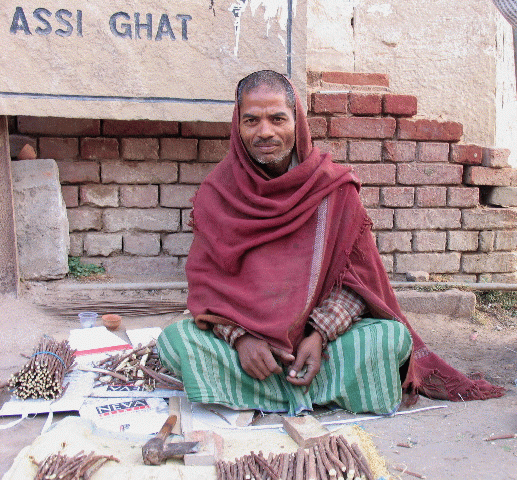
There were the ever persistent touts that fill the ghats and streets of Benaras, selling everything you can think of and offering to get for you, 'no problem', even what you cannot think of. There were spiritual bookstores and exotic performers of bhajan music, singing the names of Shiva or Ram.

There were sadhus with their orange robes and piled jatas of hair,

There were old Ma’s and children, living out in the open on a table.

After I checked into the hotel, had a shower and 5-minute rest, Antoine came and got me and we went out. He was hungry and we soon found a restaurant and had a wonderful Indian meal. Then we went down to the ghats, the miles long stone bathing steps that line the Ganges in Benaras.

Assi ghat is the southernmost of all of the ghats and is built
where the Asi River flows into the Ganges.
After that, the banks of the Ganges are mud-lined and not built up
with steps or buildings.

There is something different about this city, about the feeling here. Antoine said that I could stay here for a long time . . . it is true. I feel I could write here -
it is archetypically intoxicating.
You never see this quality in America, the closest thing to it are some neighborhoods in New York City, but this is different. I said to Antoine, 'Compared to this, the wild west was a Sunday church picnic' and I really meant it.

Even in India, one does not see this particular rasa or taste in a city.
It seems a place differently and uniquely blessed.

After dinner, we began to walk along the Ganges, north, upriver along the ghats.
Ganga Ma (Mother Ganges), is large and slow moving here.
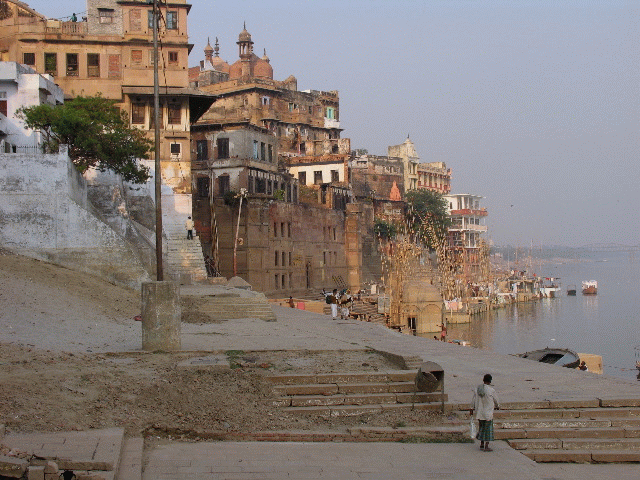
Throughout India, the Ganges is the presence and focus and source of life,
just like a Mother, and this Mother is considered to be Divine:
“The water of the Ganges is regarded as an elixir. Taken daily it confers immortality. A bath in it, purifies one of all sin. Applied to various parts of the body while performing a penance, by standing in the river on one leg from one new moon to the next, it can cure diseases of those parts and organs.Voluntary death by drowning in the sacred stream assures one a place in paradise. Even consigning the bones and ashes of a deceased person to the river ensures his/her entry into bliss.The Puranas relate how a bone of a dead dog, while being carried over the Ganges by a crow, was accidentally dropped into the holy waters, as a result of which, the dog was instantly translated into heaven.”
– Benjamin Walker, Hindu Tales
In Benaras, all things run down to the Ganges. The stone steps of the Ghats, which continue for several miles and were built over a long period of time going back before the early Medieval age, all run down to the Ganges.
As you look along the ghats, they all run into each other without a break for as far as the eye can see. The steps go up or down from one to another particular ghat. Each Ghat has its own particular quality, many quite striking in grandeur and beauty, while others are more subdued.


After walking past one or two ghats, one of them with some young Indians playing Western rock music, we heard a boatman beckoning us to hire him and we did. He brought his boat up to the muddy shore below the steps, filled with trash and we stepped on board.

It was wonderful, as we began to go out onto the Ganges.
I began to feel that I had now, begun to enter Benaras.
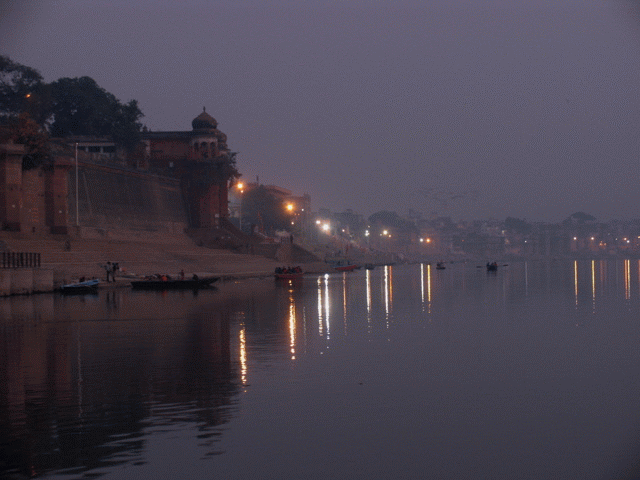
It was peaceful and quiet with the bright lights that (now) line the ghats
shining out towards the river,
like streetlights in the distance.
The high walls of the various ghats seemed like large castles,
or ancient redwood trees,
as they rose up from the Ganges.

Here and there I hear dthe music of bhajans and chanting
coming from the innumerable small porches, balconies and rooms that fronted the river.

Here and there I could hear a dog barking or see an occasional firework go off in the sky.
It was Divali (a sort of Indian New Year) tomorrow and everywhere people were practicing.
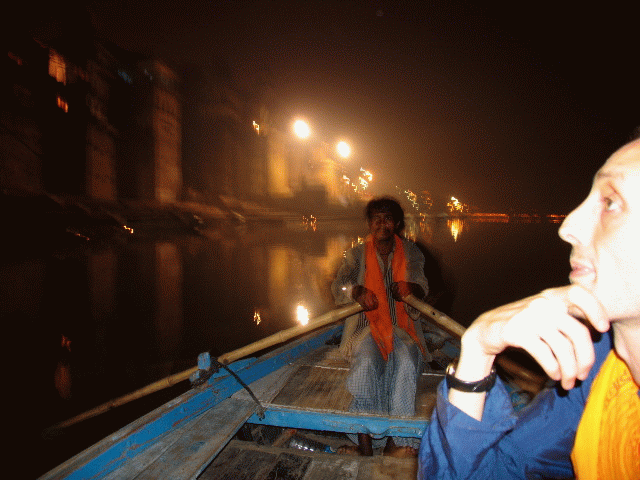
In the boat, Antoine asked me if this was what I expected of Benaras and I said ‘No’, meaning less of the lights and the occasional hotel that now fronted the river as well as various stores that had come right down onto the ghats. After a discussion of where it would be best to go, we decided to head for the main burning ghat or Smashan of Benaras - Manikarnika Ghat.
One of the most intersting things about Marnikarnika Ghat, and the other burning Ghat of Benaras- Harischandra Ghat, is that unlike the cremation grounds in the rest of India, which are considered impure, polluted and are typically located outside of the city, here, the cremation grounds are set in the very heart of the city. This tells us much about the special nature of Benaras and the particular significance given to cremation here.
In Benaras, cremation is considered to be Liberation; it was the boon given to Vishnu, from Shiva, that all beings who die here would be Liberated. This forms the foundation and fundamental myth of Benaras. It shows in the central location of the burning ghats to the city as they are usually considered to be impure and polluting. But here, they are considered to be places of Liberation and are located
in the very heart of the city.
It is so obvious and clear in India, especially here in Benaras, how story fills in, fills up, completes, points out, makes, creates, reveals and also hides the world of our experience. As the famous Sanskrit grammarian Bhartrahari once said, “Unless we have a word for something, that something does not exist for us” It is the same with story; which is a collection of words. Unless you have a story for something, that something does not show itself to you. Unless you know the myth, one place is like any other place, and Benaras, as I have proposed before, has more myth and story per square inch than any other place in the world.
I could see the many fires of Manikarnika Ghat, burning off in the distance, reflecting onto the still water of the Ganges
as we slipped slowly and quietly toward it.

As we approached, I could feel the weight of something real and heavy, immovable and ancient, I could feel something eternal. There were six or seven fires burning, and the ghats were covered with people.

The most busy of these people were carrying logs on their heads, from the boats which crowded up against the foot of the ghats where the fires burned, covered and piled high with logs. Men dressed in dirty T-shirts and lungis carried 2 or 3 logs at a time, up past the bodies laid out on the steps on green bamboo palanquins. This went on continuously.

The bodies intended for cremation had been carried down a narrow twisting maze through the close-set alleys of shops, houses and stores, by their families or relations. They were then set down on the steps by the Ganges, wrapped in orange shawls to wait for the next available burning pyre. Drawn by the ancient promise of Shiva, people came from all over India to be cremated here in Benaras and to have their ashes scattered on the Ganges.
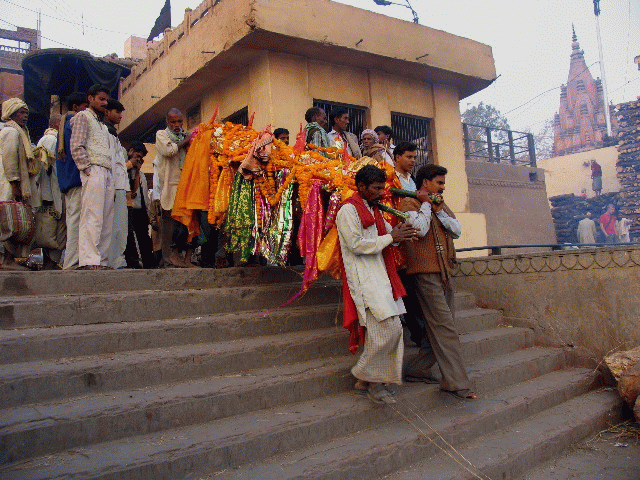

First, the bodies are given a bath in the Ganges, then, they are placed by the river, feet down, in front of strangers and groups of people
who have come to witness the burning.

The people assembled here have come for a variety of reasons; perhaps, they had obligations to those who were to be cremated. They had loved and lived with those who were now dead. Perhaps they had simply been around or known them, or perhaps they came to be confronted with their own inevitable death and burning and found solace and comfort in that fact and in reality itself, an opportunity denied to us in the West where the face of death is kept hidden, even in the news. I think many of them came for all these reasons.
The large, high, and many-storied buildings that rise above the ghats seemed ancient. They were covered with a brownish black haze of hundreds of years of soot and ash from the constant burning of the dead 24 hours a day, seven days a week, every day of the year. They were heavy with all the death they had witnessed; everything was darkened and burdened with weight and solemnity.

Just beside the main ghat, there was a huge, ornately framed stone archway that was choked with crumbled rock and assorted trash through which a small stream of water spilled down and onto the stone rocks of the lowermost ghats where the fires burned. I could hear the water running over the wall and falling onto the stone below as we approached the cremation site; I could hear the fires burning and crackling; I could hear logs shifting on the fire and the chanting of priests. Everywhere I stepped, it was completely dirty and usually wet.
There was not a single clean area to be found.

One thing I noticed in Benaras, is that cleanliness, as we use the term in the West, is not always associated with holiness or even with a life worth living or a value worth striving for. Everywhere it is dirty. The holy men are dirty. Out in front of the nicest hotels, there are beggars, and they are dirty. They are not driven off or kept away like in America, where we try to maintain our own version of ‘cleanliness.’ Our hospitals are kept white, washed, and sterile as if it is germs alone that cause disease. I was in a hospital in India for several days, and according to the germ theory of disease we have in the West, the Indian people should be the sickest of any population on earth, but they are not. Even the small hospital I was in would be considered dirty by Western standards. But, Hindus do have an extremely exacting idea and practice of purity, sacredness, and ritual in regards to religion; but, this does not necessarily include what we in the West would call ‘cleanliness’.
There is cow dung and buffalo dung and dog shit and human shit, and the streets are dirty, and you see men urinating and people shitting everywhere, and there is the recognizable smell of shit and urine, and there is exhaust from diesel trucks and smoke from fires and the streets are littered with trash and more shit, and when you get a haircut, you sit on a flat stone on the ground, and the barber sits on a flat stone in front of you beside a dirty, busy street with a pile of cow dung a few feet away and the whole place is buzzing with flies

And the street you are sitting on is one which goes down to the ghat which is on a river which is the holiest in India and is itself polluted with fecal matter from the thirty streams of untreated sewage that constantly flow into it in Benaras alone and in which people come to bathe and to brush their teeth and the milkmen wash their buckets,

while the occasional dead body or only partially burned corpse is floating and just a little ways upstream is the place where the ashes of burned bodies and some of them only partially burned because the people who brought the body there could not afford enough wood, are daily poured into the river.
India is not clean.
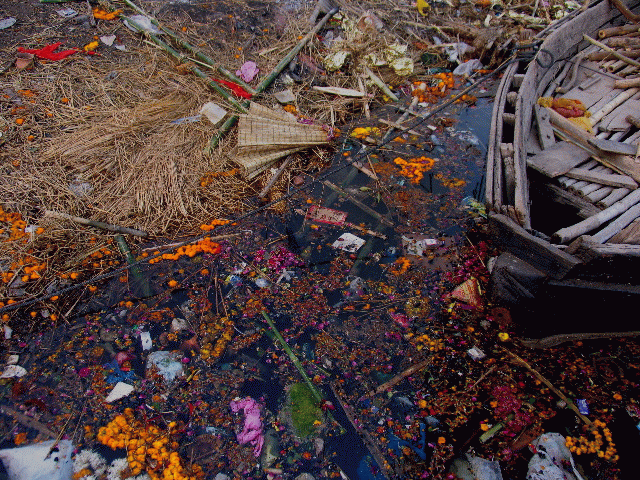
I had to watch where I put my foot, as all over the place were piles of cow dung, fine debris and not so fine debris and sometimes it was deep. Everything was dirty, blackened and browned, everywhere was dirty and there was a strange sort of perfection and even orderliness or sanctification to it all as well. Like a forest where the leaves, dead branches, flowers, sticks, rocks and death of so much living matter reveals itself as beauty, so was it here.
Here, I could imagine, as Ramakrishna saw - Shiva, the great God of Death and Life, walking the ghats and receiving the souls of the departed. I found it absolutely beautiful and serene. Something real, something natural was happening here and always had. This was Benaras; a city renowned for death and eternal life and this was the very heart of that city.
We are so starved in the West for something real. What does that really mean? Perhaps, what is ‘real’ refers to what man cannot control, what man cannot prevent or pervert. It certainly includes a clear encounter with the most ancient mystery that man encounters . . . death.
Here in the burning Ghat was the India that I had dreamed of and knew I had dreamed it only when I saw it. Although Manikarnika Ghat was small and only a small sliver of what once was a whole culture, city, country and time, it was still here and still alive. When you walk through a doorway, it can be small and yet open out to another room that is wide and vast as a world. So it was for me with Manikarnika Ghat in Benaras.
In the felt heat of the burning fires, we paid our boatman and walked to the burning ghat. The whole place was charged with intensity and serenity at the same time. There were groups of people at various places all over the ghat at higher and lower levels. I later discovered that they were mainly the relatives of the departed. It was all men, there were no women present, except amongst the few Western white people or ‘Fairangis' as Antoine called them, as we sat on the upper stairs and looked on.

The buildings above the ghats rose up like great trees in their height above the lower steps where the Ganges was filled with garlands of flowers, thousands of plastic bags and trash at the base of the burning area. There were large, old wooden boats there, piled high and wide with wood, four-foot long logs for the burning. Higher up the stairs of the ghats were even more logs stacked 20-30 feet high,
often in unstable looking piles.

Cows, goats, buffalo and dogs roamed the area. There were men wearing only dhotis and dirty t-shirts attending to the fires, carrying the wood off the boats and building the pyres. It was busy, awesome, peaceful, serene and passionate and all at the same time. It was Benaras - the taste of all things mixed together.
I walked up to the higher steps, above the crowded press of people, sat down and watched, feeling as much as I was watching; and there was so much to feel, most of it passing me by.
I know that now, by the grace of Ram, the God and the man named after him who walked up to me on the steps, sat down beside me and began immediately to tell me what was happening below. In India, there are many people who will approach a Westerner for a variety of reasons, many of them, at least in the cities, are simply trying to scam you and I suspected this small man, short, wiry but with a kind face and very good English, to be one of them.

He immediately, without any introduction, started to tell me what was going on below on the Ghat. Pointing to a group of men bearing a palanquin down the final steps to the river he said:
“They are from Calcutta, they have brought the body only today for burning” He spoke of a group bearing a palanquin down onto the burning grounds. “When they bring the bodies down the steps from above they are chanting 'Rama Nama Satya Hai!' and the group answers back with the same call, Rama Nama Satya Hai!"

"This means 'Rama is the name of the Truth of existence. This is the fate of all.”
Indeed, they did chant this call and response again and again and again as they threaded their way down the narrow alleys and past the small storefronts and stalls that open up directly upon the cobblestoned way of the ancient paths of Benaras.
“For thousands of years, they have come this way.
All day and night, every day and night.”
And sure enough, as if on cue, there came another group of mourners, entering through a final arch out onto the top steps of the ghat, bearing the corpse of their departed with them on bamboo poles, wrapped in brightly colored cloth and adorned with flowers. The face of the deceased was covered with a white shroud, but you could see the outlines of his body clearly. The man leading the procession and the chanting was topless, dressed in a white dhoti, and with a shaven head. “He is the eldest son” Ram pointed out, “It is he who shaves his head and who leads the chant and performs the karmas that need to be done. There are no women here; this is a place of karma, not emotion. Women cry, and their crying may hold the soul to the world or cause sickness to them and be bad for the soul so that it cannot leave. Men cry, but they do so internally; they do not show it. This is a place of karma; there are actions that need to be done, and men are the ones that do it.”

Ram continued, “See how they take the stretchers down to the Ganges
and dip the corpse in the water of the river.
Then they bring it out and lay it with feet pointing downwards on the lowest steps,
right next to the river."
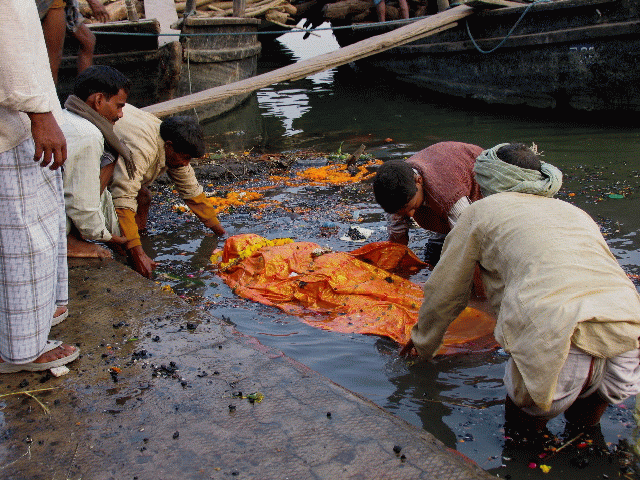


Then the eldest son, barefoot, wades into the river and brings in his cupped hands the Ganga water, which he then pours into the mouth of the deceased.” I had not noticed this small detail and began to be thankful for what this man was bringing to my attention. It was, indeed, all going on, as he pointed out. I began to think that Ram was a guide who worked the ghats and told tourists the story of what was occurring. I had no idea how true this was or in what way it was true. I did not know the story, but, we will come to this.
“Then they pour the Ganges water directly into the mouth of the deceased, taking off the outer shroud. They repeat this three times. Then the corpse is carried to where a pyre has been prepared of banyan wood unless you happen to be very rich where the wood used is sandalwood."

Notice how so many bodies are burning”, said Ram. “Have you ever burned your hair if you cut off some of it? Have you ever noticed how bad that smells? Have you noticed that there is no bad smell?"
"It was true," I said and began to wonder at the man who had so much to say and such an interesting story to tell. I had not noticed any bad smell of flesh being burnt.
“This is because of the Banyan tree logs," Ram said.
"They work in such a way as to make null the smell.”

He went on, “Sandalwood logs cost very much. It only costs rs300 ($9) for enough Banyan wood to burn a body. Sandalwood is only affordable by the very rich. I help out at the ghat where widows, because of the blessings of Kasi(Benaras) and the promise of liberation, come to die. They live there until they die. I take care of them."
He pointed up to where a large brown black building rose above the burning ghat. Antoine, too, had told me before of such a thing. I was also familiar from reading about the tradition of widows who come to Benaras to die. Indeed, many people, once they arrived in the sacred city, never left it for any reason, as they might lose the especially blessed opportunity to die here and thus be liberated. They are called: 'Kasivadins.'
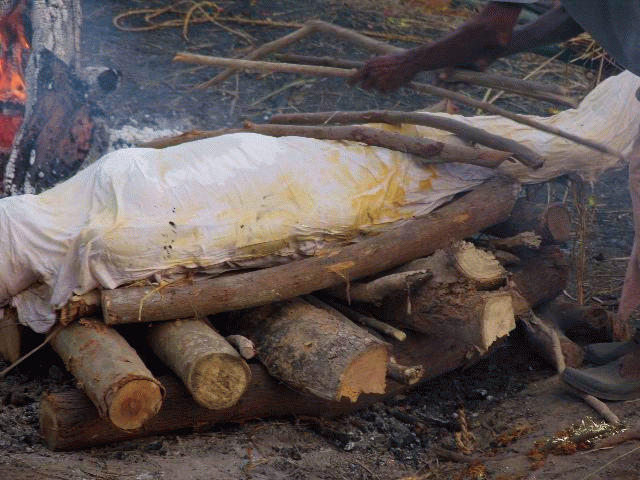
Ram had slipped this last mention about the widows into our considerations without pausing. At this point I put my fingers to my lips and tried to make him stop his discourse for a while. There was so much going on that was so strange and wonderful and I wanted to observe it in silence for a while. Ram smiled and acceded to my request.
I told him, “This is my first time here, and I want to take it all in without having to pay attention to your story for a bit.” After about five minutes, I stepped down to a lower step so that my head would be closer to his, and Ram like it was only but a moments pause, began to talk again:
“There are two burning ghats in Benaras. One, the Harishchandra Ghat is the less used,” Ram said. “This is because it belongs to the Raja or King of Benaras, whereas Manikarnika belongs to Shiva”.

I later discovered two stories about how Manikarnika Ghat received its name and special blessing. The popular version is that Shiva and Parvati were sitting by a tank or well there when Parvati's jewelled earring fell into the well. (A Jewel is known as a ‘Mani’, and ‘Karnika’ is well.) There is another version of the story from the ‘Kasi Khanda’, a mythic story about the city of Benaras (Kasi).
In this story, the well was dug by the God-Vishnu when he began to practice tapas or asceticism at the spot. Vishnu dug the well with his own discus and filled it with his own perspiration. While Vishnu was involved in His tapas, the God Shiva arrived. Looking into the well, Shiva beheld the brilliance of a hundred million suns and became filled with adoration and praise for Vishnu and offered to Him any gift he desired. Vishnu, greatly pleased, requested that Shiva always dwell with him at this place. Shiva was so thrilled at this request that he shook violently with pleasure, and an earring of his, the Manikarnika, fell into the well.
Vishnu also received a boon from Shiva that this place, Kasi/Manikarnika, would be a site that would bestow Mukti or Liberation on all things and beings that die here. Furthermore, Shiva proclaimed this as the foremost and most effective pilgrimage site on earth. It is by this well that Manikarnika Ghat is built, and for this reason, it is the most holy and sought after site of cremation in all of India.
(Below is a picture of the Manikarnika Well or Kund. It is situated behind and slightly downriver of the Manikarnika Burning Ghat. As I found in many extremely venerated spots in Benaras, this sacred spot was very dirty and in a state of great disrepair. I was told there are temples under the mud here.) The well or kund fills up with water every year when the Ganges floods.

"Look at the man down in the water in front of the ghat," said Ram. "He is looking for gold from the teeth of those who were cremated. He is feeling with his feet. He is an educated man. You should talk to him."
Looking down at the area where Ram had gestured, just beyond the last steps of the ghats, where many bodies were laid out, and the final ashes of those who had been burned were poured out, was indeed a man, well built and healthy with a pan in his hand, feeling the sandy bottom of the river with his feet.

“Look at the when the eldest son takes an earthenware pot and goes down to the river where he fills it up and then walks back to the corpse. Facing the river, standing at the feet of the corpse he then throws the pot, filled with water, over his shoulder. It shatters and breaks on the last remnants of the burning pyre, and he walks away without looking back. They are done with their relationship to the body. When the fire cools, the soul is at peace”, Ram said. “Then the whole family follows him up the ancient steps and they walk away without looking back”.



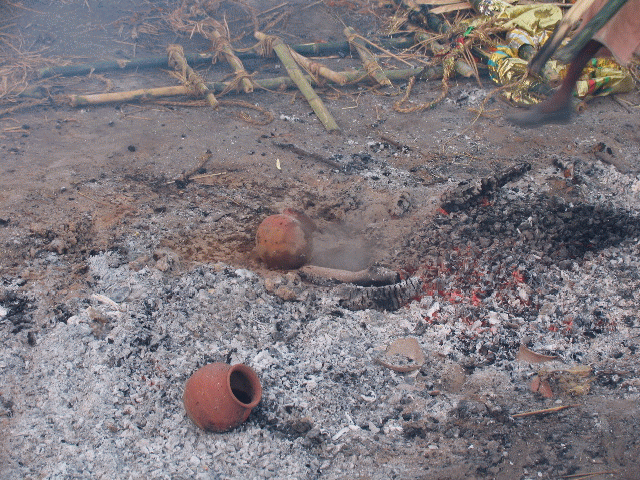
At this point, the power went out all over town. This happens almost daily in India, but it could not have been a more opportune moment. The scene became even more ancient and lit only by fire, like all of the ancient world at night, and the wonderful evening continued.
We had gone down to the lowermost steps of the ghat, right beside one of the burning bodies. The wood was piled almost four feet high, and when lit, it made a strong and hot fire. At one point, Ram gestured forcefully to one of the men tending the fire of the cremation to bring something. A plastic bag was brought to him, and Ram, talking in Hindi, instructed the man to do something. The bag was then opened and poured out onto the corpse.
“It is sandalwood. It will make the body burn brightly,” said Ram.
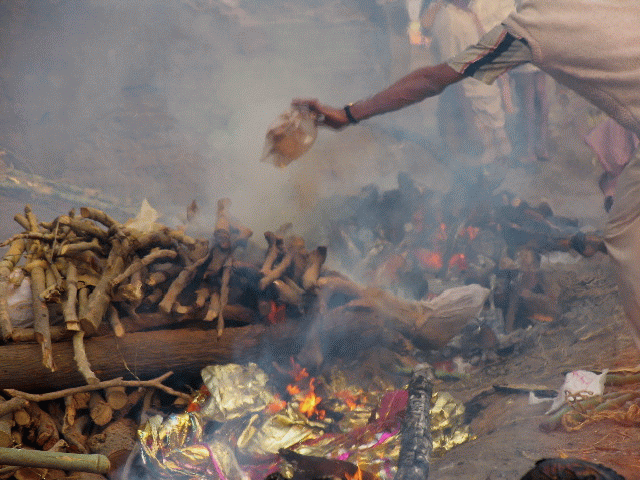
At this point, I realized that Ram had a peculiar role on the burning ghats.
“Who are you? I asked. What do you do here?”
"I have worked here at Manikarnika ghat all my life. I also work at the house where widows wait to die.” He pointed up and over to a balcony with a dark façade looming over the smashan."
I was overcome, all of a sudden, with a desire to give something to this simple man. ‘What can I give you?’ I asked him. “Oh’ if you just give money to these widows, I will be happy; that is enough. Come, see them for yourself”, he said,
and we began to walk up the steps from the burning area.

We ascended through a flat area just above the fires, where there were huge piles of logs stacked 20 feet high and the omnipresent water and filth; even the dirt seemed to have been there for eternity. We walked around an ancient temple and then up a stairwell reeking of urine and very dark. Everything we walked on and through was stone, brownish-black, and covered with particular soot and dirt that seemed unique to this area. It was partly the ashes of the dead.
When I later looked at the Manikarnika Ghat area during the day, the whole area really did appear to have a different, soot-stained aura.
We arrived in a large, rather dark, completely unfurnished room without a stick of furniture. It had a grand, always-open balcony to the smashed below.
“Here are the widows I spoke of” Ram said. There, crouched and squatting or sitting on the ground, were many older women, obviously poor and dirty, all bringing their hands up to me in ‘Namaste’. Ram stepped back, and the scene played out like an Academy Award-winning, poignant, touching drama upon my Western-influenced sentiments. I was standing at a portico looking out on the ancient Ganges at a place where they had been burning bodies continuously for thousands of years. Since before, Jesus walked the earth in Jerusalem. Since the time of Solomon, Buddha, and Sankara, all this came thundering into my memory, and suddenly, I wanted to give everything I had to the widows to help them.
I brought out my clutch of money, emptied it, and gave it to Ram.
He gave some to the women and put the rest in his pocket.
“I have been here all my life,” said Ram. “I am untouchable. I work here. This is my life. My Father was here, and his Father was as well. I have always been here.
I am a Dom.”
“In the bazaar, if I have to drink water, I cannot touch the glass. They pour it down to me. The locals don’t allow me in their homes, nor will they come to my place,” he says. “I am not even allowed into the holy temples.”
Suddenly, the pieces of a strange, wonderful puzzle came together. I realized that I was talking to one of the head men of the Doms, the lowly caste of those who take care of the corpses, who accomplish the burning, who manage the pyres, night and day of the most famous and ancient smashan (cremation ground) in the world. The smashan of Manikarnika.
How grateful I felt for all that had been shown to me, and how thankful I am for all the delight that has been poured upon my head.
Now, I knew why Ram knew so much. Now, I saw how intimate he was with this place. I looked at his face; he was a small and slender man.
“Sometimes people call out to me as if I am a boy,” said Ram, “Then I turn around, and they see my beard, and they say ‘Sorry Uncle.’ "You," he said, referring to me, “are a big man and always get a man's respect.”

I asked Ram, “How did you learn such good English?”
“I met an English woman here, a doctor, and I taught her Hindi, and she taught me English.” He had a good face. I liked him immensely.
The next afternoon we again went to see Ram as we had set up a time to do so and perhaps take some pictures at the burning ghat. Taking pictures at the ghat was prohibited, but when I asked Ram if I could do so, he said he could set it up for me.
Antoine got there first, and I was a little late, as it was the festival of Divali, and the traffic in Benaras was even more jam-packed than usual, with carts and cycles and people and cows and buffalo and soldiers. There were many army men in the streets with guns, presenting a formidable presence to any who sought trouble there. Here and there, everything just plain stopped. Even when I went down the narrow alleys to the Manikarnika ghat, everything stopped.
I came upon a body, held up above the crowd on a bamboo stretcher, brightly colored in his or her wrapping, feet leading the way, being carried down to the ghat to be burned. Everything had halted, and we waited, packed in the small alleyway, while someone had an argument that continued to the sounds of ‘Rama Rama Satya Hai, Ram Ram Satya Hai.’ There was no room for more than two people to pass side by side in the alleyways.
When I was almost to the Ghat, a young man who spoke good English and seemed well-educated approached me. He asked me where I was from, and I told him, “From America.” He then asked if I was going to the Ghat to see the burning. I replied that I was going to see that and also to meet a man named Ram. The boy said he knew the man, and he hoped I had not given him any money. He said that he is an alcoholic and runs a scam there, saying that he works at an old folks home and takes people up to the apartments there. He pointed to where Ram took me last night. Then he said that Ram takes the money himself.
Well, well, well, such is the fortune of a Fairangi in India. What a revelation. I did not have time to ask him any further questions as we then saw Ram approach from below on the burning ghats, and the young man begged me not to tell Ram he had told me any of this or that Ram would beat him. When Ram approached, the young man was effusive in his greeting and left hurriedly, with a last glance towards me that I understood to say, ‘Please do not tell Ram.’
At first, I thought, “How soon this dream has gone, how brief and wonderful. But wait, could this not be a deeper part of the dream, a further twist in the plot?” Suddenly, a new feeling sprang to my heart, born of being an 'actor' in the workings of this exotic play. I warmly greeted Ram with a twinkle in my eye and a newfound appreciation and shared mystery. I felt neither of us knew what was happening, although I had just become more unknowing. I surrendered to that ignorance. Now, I could participate in this ‘play’ with a new, more 'conscious' role. We began to walk towards where the bodies were burning, deeper into the story.
Many centuries ago, the great poet and saint Kabir who lived most of his life in Benaras sung a poem about Ram. Talking about Rama, one of the Avatars, an incarnation of God of the Indian tradition, Kabir told how Ram or God has deluded the world through His Maya or Illusion. His poem somehow related to my experience in a unique and exquisite way. Kabir said:
That con man Ram has conned the world.
With his conjuring, he snatches away your roots.
No one can see Ram's trickery.
Kabir's heart accepts the thief.
Cheating disappears
When you recognize the cheat
To see more Pictures of Manikarnika Ghat and Benaras
To view Movie/Slideshow of Benaras and Manikarnika Ghat
To view other stories from India: